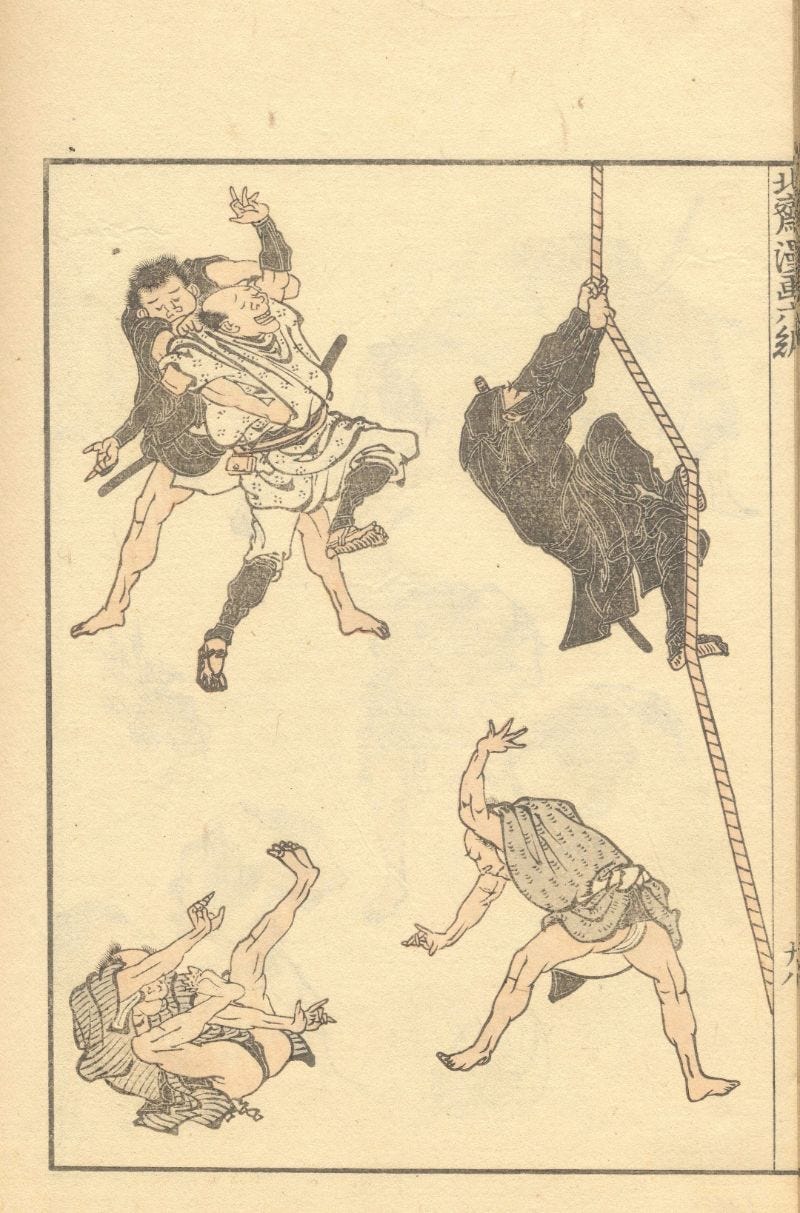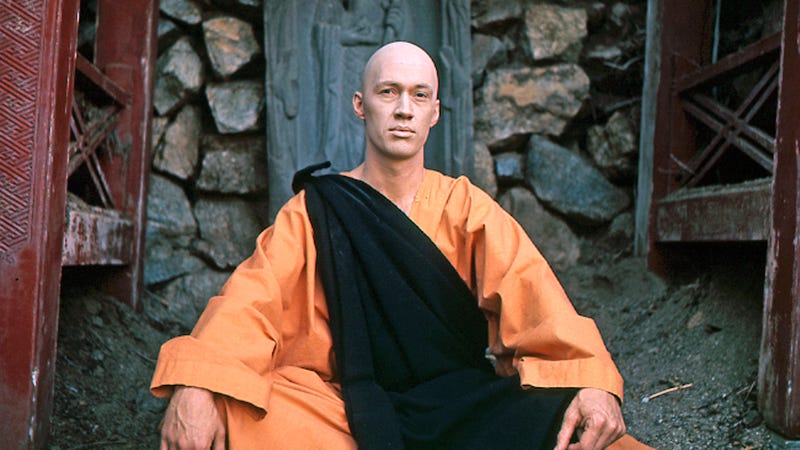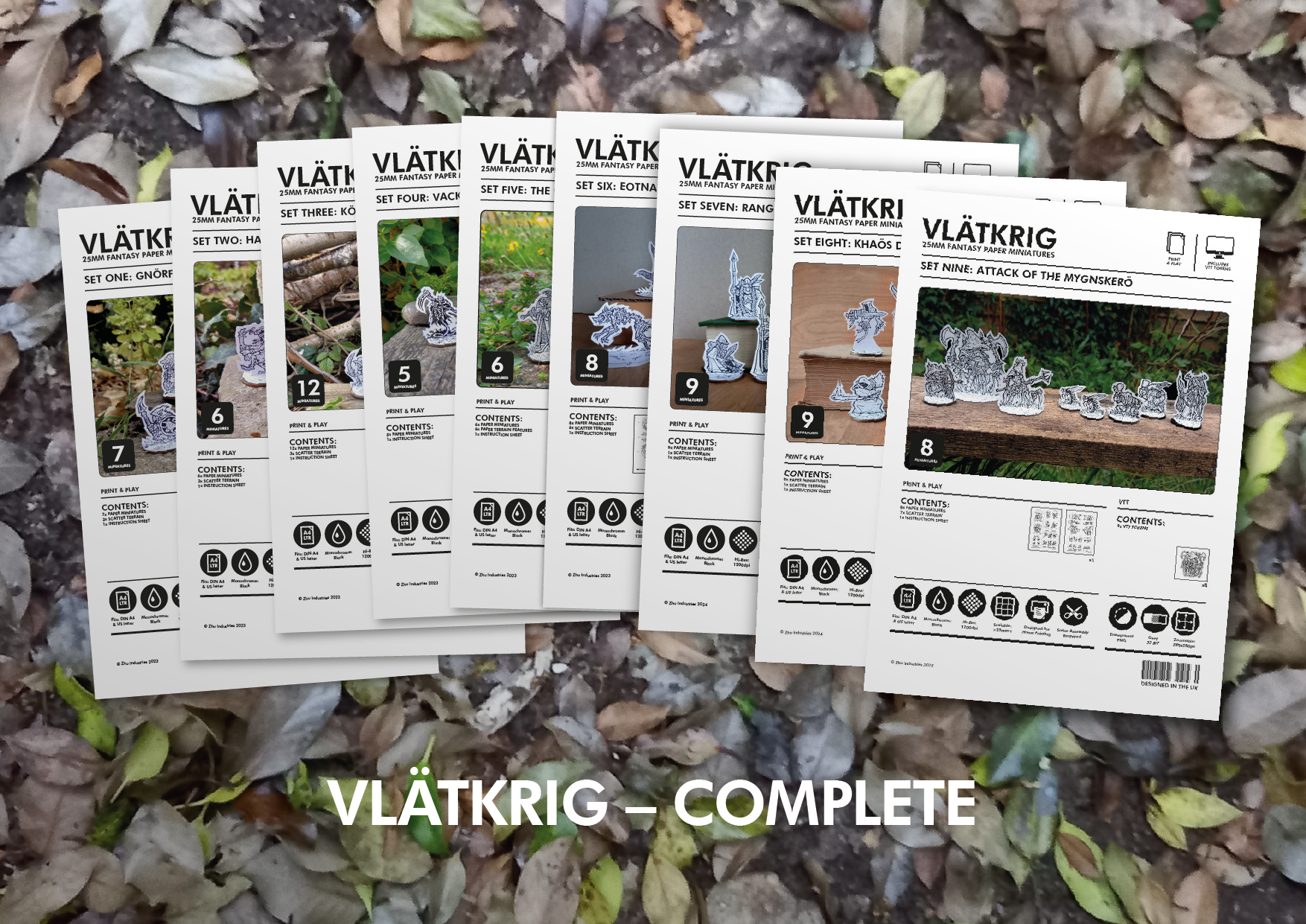It has been a truth long acknowledged by Oldhammerists that the Warhammer World was cobbled out of Citadels existing historical and fantasy miniatures ranges, rather than created out of whole cloth. It weaves in elements such as Araby, Cathay and Nippon, not because there was some grand underlying world building motive, but simply because Citadel made miniatures of historical Arabian and Oriental figures, and Ye Olde Warhammer was ultimately designed as a marketing tool to sell them.
Early in 2018 Gideon over on Awesome Lies completed a series of excellent blog-posts covering the Warhammer Japan proxy "Nippon", covering ground such as the cultural milieu of late 70s early 80s japanomania encompassing Hai-Karate and Bruce-Lee movies, considering the published written sources on Nippon, from Warhammer 2nd Edition, Ravening Hordes, WFB3 and WFRP moving on to review Dave Morris's excellent 'but not quite Warhammery enough' Tetsubo, to speculating what a successful WFRP1e Nippon could have been like.
This inspired me to examine the sculptural and visual sources, and consider what they might tell us about the presentation of The East in early Warhammer, and perhaps outline the world it describes. However, there turned out to be a much, much larger quantity of Oriental based miniatures over a far greater period of time than I'd expected, a steady stream of releases over a roughly a five years period. Then in May Nico completed his massive and excellent Nippon Army, once again prompting me to revisit the East, but still, no, and more recently Whiskey Priest wrote up two excellent blogposts on Nippon, which again made me think I should really get this done, but the whole thing was too big and messy. So time to chop it up into manageable chunks.
In this first post, we focus on the Pre-Warhammer Citadel miniatures starting in 1982, and those released throughout the publication of the first edition of Warhammer (1983), with a slight reference to Forces of Fantasy (1984). These lay the foundations of the portrayal of Far Eastern themes in Warhammer, setting down some of the basic principles that are adhered to throughout it's five year development.
Fantasy Tribe Samurai (1982)
The first set of miniatures we meet is one of the historical ranges that Citadel produced in the early 1980s. Sculpted by Michael and Alan Perry, described as from the 16th Century Momoyama period. Known as the 'Fantasy Tribe' Samurai - something of a misnomer, as they are catalogued elsewhere as just SAM Samurai, there are foot Samurai, Ashigaru (including one armed with an Tanegashima) as well as horse-mounted Samurai and a pair of Warrior Monks who resemble the Japanese Sohei Buddhist Warriors.
The flyer clearly juxtaposes the Samurai against scimitar and pole-arm wielding Orcs. The drawings are posed facing each other as if opposing sides in a conflict and the overall effect is situating the historical Samurai into a Tolkienesque fantasy milieu, perhaps an Orcish invasion of 16th Century Japan, or a re-staging of The Battle of the Pelennor Fields from The Lord of the Rings outside Osaka Castle. The Samurai simply stand as enemies of the Orcs, stalwart heroes as the Rohirrim or Gondorians.
As we will see, this mixture of Oriental and Western Fantasy themes will dominates much of the early development and presentation of The East in Warhammer.
| The Sōhei - Saito Musashibō Benkei |
As we will see, this mixture of Oriental and Western Fantasy themes will dominates much of the early development and presentation of The East in Warhammer.
FA12: Fantasy Adventurers Ninja (1982)
| FA12 Ninja! |
Ninjas turning up in Citadels range of models is most probably in response to the appearance of the Assasin class in Advanced Dungeons and Dragons (1978), and here there is no doubt that the FA12 Ninja is being presented as a Fantasy Adventure gaming miniature, and not as a historical war gaming piece.
Ninja themselves walk a curious tightrope between historical fact and folkloric fiction. While assassins and spies certainly existed in feudal Japan, they would have typically been dressed in common garb so as to blend in with the people. The classic image of the figure in black garb may have come from “kuroko” - the stage-hands of Japanese Kabuki theatre, whose costumes rendered them 'invisible' on stage - and so their appearance became a visual short-hand for 'sneaky git' used by illustrators, rather than a historically accurate depiction of what Ninja may have actually worn.
Nonetheless, what the FA12 Ninja, hidden in plain sight amongst his fellow pseudo-medieval european adventurer types indicates is this mixture of eastern and western tropes, a motif we find yet again with our next model, Yamato Takashi.
It is notable that while the first edition of Warhammer makes mention of "Medieval and Dark Age wamiors together with Arab types and fearsome Vikings." other than a small crop of the FTO/SAM advert used as an illustration for the 'Combat' section, no explicit mention of the Oriental or Far East appears at all.
However, shortly after the publication of Warhammer, Citadel released a boxed set of miniatures entitled Bryan Ansell's Heroic Adventurers, sculpted, unsurprisingly by Bryan Ansell. This set included an insert of rules sheet for the then brand new Warhammer game. Amidst the Elric clones and pseudo-medieval european tropes of early 80s fantasy, there is a Samurai. Yamato Takashi, making him the first published explicitly eastern figure in Warhammer. He has something of an authentic sounding name, Yamoto being the name for a region, dynasty, period and ethnic subgroup of Japanese and Takashi, in some writings meaning 'Samurai', indicating him as something of an archetype. His character description however falls off the edge of offensive cliche, having him both be "inscrutable" and also appearing to be servile whilst having ulterior motives, while the model design itself is suitably heroic, and his statistics make him by far best fighter of the band of adventurers - again setting a trend that would continues through early Warhammer portrayals of Samurai as superior warriors.
 |
| Hokusai | 1817 |
Nonetheless, what the FA12 Ninja, hidden in plain sight amongst his fellow pseudo-medieval european adventurer types indicates is this mixture of eastern and western tropes, a motif we find yet again with our next model, Yamato Takashi.
Bryan Ansell's Heroic Adventurers: Yamato Takashi (1983)
| Yamato Takashi | Bryan Ansell | 1983 |
 |
| Yamato Takashi | Heroic Adventurers Box insert |
However, shortly after the publication of Warhammer, Citadel released a boxed set of miniatures entitled Bryan Ansell's Heroic Adventurers, sculpted, unsurprisingly by Bryan Ansell. This set included an insert of rules sheet for the then brand new Warhammer game. Amidst the Elric clones and pseudo-medieval european tropes of early 80s fantasy, there is a Samurai. Yamato Takashi, making him the first published explicitly eastern figure in Warhammer. He has something of an authentic sounding name, Yamoto being the name for a region, dynasty, period and ethnic subgroup of Japanese and Takashi, in some writings meaning 'Samurai', indicating him as something of an archetype. His character description however falls off the edge of offensive cliche, having him both be "inscrutable" and also appearing to be servile whilst having ulterior motives, while the model design itself is suitably heroic, and his statistics make him by far best fighter of the band of adventurers - again setting a trend that would continues through early Warhammer portrayals of Samurai as superior warriors.
C05 Specialists: Martial Arts Monks (1983)
Like the FA12 Ninja model, filled a niche in the Assasin character class, the C05 Martial Arts Monk miniatures are likely to have been designed to meet the gaming requirements of the Monk character class in Advanced Dungeons and Dragons Players Handbook.
| C05 Specialists | Martial Arts Monks |
As with the Samurai range, there are a few that resemble Sōhei, with their face coverings, at least one of which seems to be a SAM Warrior Monk but with a slightly larger axe possibly remodelled due to casting or breakage issues, while the majoirty seem to be based on the tunic, trousers and shaved head of the Chinese Shaolin.
 |
| Shaolin Monk |
Considerable years before Quentin Tarrentino finally materialised Fox Force Five in Pulp Fiction as the Deadly Viper Assassin Squad in Kill Bill vol. 1, Citadel were headlining an all-star all-female action Chopsocky sub-range of miniatures in the C05 Mistresses of the Martial Arts in the First Citadel Journal.
 |
| Mistresses of the Martial Arts | Citadel Journal |
 |
| Deadly China Doll |1973 |
The appearance of one of these Female Kung-fu artists continues through both illustration and advertising, turning her into something of a recurring Iconic Character for early Warhammer in the same way Riolta Snow or Gotrek and Felix will come to the fore in their respective generations.
| May 1983 Flyer | Tony Ackland | I kung-fu the Nazgul in the face |
Like with the Fantasy Tribe Samurai vs. Orcs flyer from 1982, in the May 1983 flyer we see an 'oriental' character - in this case the female martial arts monk - fighting traditional Tolkienesque Dungeons & Dragons type monsters, this time being the robed and hooded Nazgul on a desolate hillside in a scene reminiscent of the Battle of Weathertop from J.R.R. Tolkien's The Lord of the Rings, where a Ranger and Four Halflings stand their ground against undead spirits, and it's hard to imagine that iconic reference wasn't the original intent.
Our female martial artist is somewhat reminiscent of David Carradine in the early 70s tv-series Kung Fu in which a Shaoling monk of American-Chinese parentage travels across 19th Century America in search of his long lost brother. This theme, of a hero being trained in the Martial Arts in the 'east' then heading to distant western lands is by now a common trope in genre fiction, influencing everything from the 1970s Iron Fist to the 2010s Batman
Conversely it is equally possible to imagine the Ringwraiths, Elves and Zombies could be fighting in the ruins of an ancient ruined Shaolin temple, it's hard to distinguish the architectural style from ruined cyclopean masonry, but there are no clear Oriental references being made in the images architecture or scenery.
The same Female Martial Arts Specialist also appears in Forces of Fantasy (1984) in the image above, of a European medieval, 1960s style Robin Hood being out-shot by our top-knot wearing, be-tunicked female assasin-monk. The trees and foliage don't seem particularly Far Eastern, and the Robin Hood figure suits a Sherwood Forest, so it is simple to read the image as a European fantasy landscape. The image is quite amusing on a number of levels, one is that the bowman is the exact same fellow used to illustrate the Shooting section in Warhammer 1st Edition, here being given his come-uppance in the Return Fire section of Forces of Fantasy.
Again, I have to say Tony Ackland is second to none for building these kind of narratives into his imagery, I don't know of any illustrator from the early 80s who really brings tabletop rules to life in such an effortless way, it's not just fantasy art, but fantasy art about gaming. There is also some irony in Robin Hood, folk hero fabled bowman of Ye Olde England being out by a female Eastern Martial Artist with a crossbow pistol, symbolically killing off the old well worn fairy-tale, ushering in a brave new dynamic era of sensibly dressed female Fantasy!
To summarise we have miniatures:
If we extrapolate from that idea, the very early Warhammer world is one in which Questing Knights are perhaps just as likely to be fighting great Yokai as Samurai are to be found defending isolated villages against marauding bands of Orcs, where Mistresses of the Martial Arts rally Wood Elves against the sorcerous powers of the Undead, and Ninja are sent against the daemonic servants of Chaos. This is perhaps a world where global travel, while fraught with danger, excitement, and adventure, is much more common than the historical analogue at a similar point of technological development, and the fantasy gaming possibilities that such a milieu where borders are irellevant and culture is set free from the moorings of geography afford are ripe for development.
Overall, the idea that Fantasy in general, and Warhammer in particular of the early 80s was primarily concerned with reproducing a Pseudo-Medieval Fantasy Europe is evidentially mistaken, no doubt some groups of players took that stance, the attitude at Games Workshop and Citadel evidences a much broader pallet of references.
Next Time, on Furui Hanmā: A Journey to the East... It's 1984, and everything explodes. C05 Specialists transmute into the C05 Oriental Heroes, there are strange new models, new boxed sets, historical heroes figures emerging from the mists of time, and the grimacing face of Oriental Evil is revealed...
 |
| David Carridine | Kung Fu | 1972 |
Our female martial artist is somewhat reminiscent of David Carradine in the early 70s tv-series Kung Fu in which a Shaoling monk of American-Chinese parentage travels across 19th Century America in search of his long lost brother. This theme, of a hero being trained in the Martial Arts in the 'east' then heading to distant western lands is by now a common trope in genre fiction, influencing everything from the 1970s Iron Fist to the 2010s Batman
Conversely it is equally possible to imagine the Ringwraiths, Elves and Zombies could be fighting in the ruins of an ancient ruined Shaolin temple, it's hard to distinguish the architectural style from ruined cyclopean masonry, but there are no clear Oriental references being made in the images architecture or scenery.
 |
| Martial Arts Monk, with crossbow | Forces of Fantasy | Tony Ackland (1984) |
The same Female Martial Arts Specialist also appears in Forces of Fantasy (1984) in the image above, of a European medieval, 1960s style Robin Hood being out-shot by our top-knot wearing, be-tunicked female assasin-monk. The trees and foliage don't seem particularly Far Eastern, and the Robin Hood figure suits a Sherwood Forest, so it is simple to read the image as a European fantasy landscape. The image is quite amusing on a number of levels, one is that the bowman is the exact same fellow used to illustrate the Shooting section in Warhammer 1st Edition, here being given his come-uppance in the Return Fire section of Forces of Fantasy.
Again, I have to say Tony Ackland is second to none for building these kind of narratives into his imagery, I don't know of any illustrator from the early 80s who really brings tabletop rules to life in such an effortless way, it's not just fantasy art, but fantasy art about gaming. There is also some irony in Robin Hood, folk hero fabled bowman of Ye Olde England being out by a female Eastern Martial Artist with a crossbow pistol, symbolically killing off the old well worn fairy-tale, ushering in a brave new dynamic era of sensibly dressed female Fantasy!
Conclusion
Before wrapping up what this means for Warhammer, it should be noted that the East-meets-West themes are by no means unique to the Citadel ouvre in this period. In AD&D kung-fu monks, Ki-Rin, Ogre Mages and Samurai Hobgoblins in lamellar armour rub shoulders with Orcs, Elves and Dragons, and fan-made classes for the Ninja and Samurai classes in D&D appeared very quickly in the mid 1970s. Citadels ranges were designed to meet this demand from fantasy gamers, as much as they were to provide historical wargamers with suitable miniatures.To summarise we have miniatures:
- Samurai
- Ashigaru
- Tanegashima
- Sōhei Monks
- Shaolin Monks
- Mistresses of Martial Arts
- Ninja
Then if we examine the relationships with other factions they are portrayed alongside:
- Samurai Armies fight Tolkienesque Orc Armies.
- Samurai allied with medieval fantasy adventurers.
- Samurai fight against Chaos Marauders
- Ninja appear alongside medieval fantasy adventurers.
- Shaolin Monks fight against Tolkienesque Undead.
- Shaolin Monks allied with Tolkienesque Elves and Rogues.
- Shaolin Monks kill Robin Hood.
- Shaolin Monks can be male or female.
- Oriental types appear in Western Landscapes.
- Western types do not appear in Oriental Landscapes.
If we extrapolate from that idea, the very early Warhammer world is one in which Questing Knights are perhaps just as likely to be fighting great Yokai as Samurai are to be found defending isolated villages against marauding bands of Orcs, where Mistresses of the Martial Arts rally Wood Elves against the sorcerous powers of the Undead, and Ninja are sent against the daemonic servants of Chaos. This is perhaps a world where global travel, while fraught with danger, excitement, and adventure, is much more common than the historical analogue at a similar point of technological development, and the fantasy gaming possibilities that such a milieu where borders are irellevant and culture is set free from the moorings of geography afford are ripe for development.
Overall, the idea that Fantasy in general, and Warhammer in particular of the early 80s was primarily concerned with reproducing a Pseudo-Medieval Fantasy Europe is evidentially mistaken, no doubt some groups of players took that stance, the attitude at Games Workshop and Citadel evidences a much broader pallet of references.
Next Time, on Furui Hanmā: A Journey to the East... It's 1984, and everything explodes. C05 Specialists transmute into the C05 Oriental Heroes, there are strange new models, new boxed sets, historical heroes figures emerging from the mists of time, and the grimacing face of Oriental Evil is revealed...




/pic286405.jpg)




